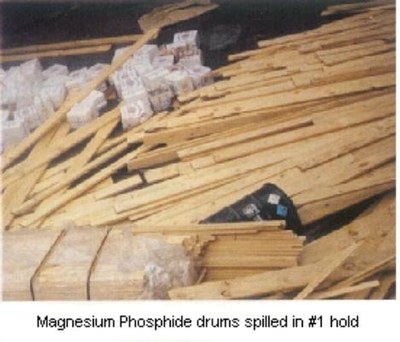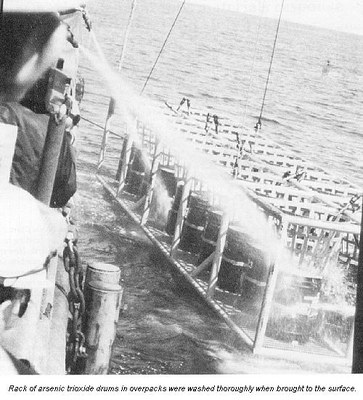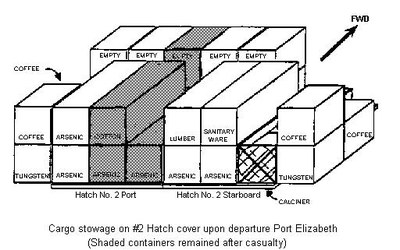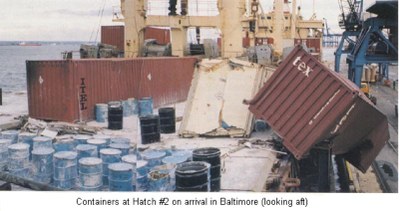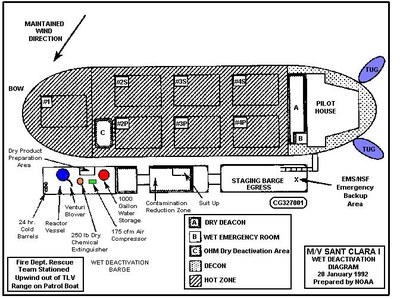1992 - Santa Clara
| Year | 1992 |
| Vessel | Santa Clara |
| Location | Port Elisabeth, USA |
| Cargo type | Package |
| Chemicals | ARSENIC TRIOXIDE , MAGNESIUM PHOSPHIDE |
Summary
The Santa Clara I, a break-bulk container ship of Panamanian registry, operated a regular route between ports in South America and ports on the east coast of the U.S.A. carrying containers, trucks and break-bulk cargo. It carried a complement of 28 crew members.
Among the vessel's cargo on this particular voyage were five pallets banded with two drums, each stowed on the No. 1 upper tween deck, each drum containing about 180kg of magnesium phosphide, and 25 containers containing drums of arsenic trioxide stowed as follows: 19 containers in the No. 2 hold and 6 containers on deck over the No. 2 hatch cover (see Figure 1). Each container was packed with 108 palletized drums, each drum containing 140kgs of arsenic trioxide.
Arsenic trioxide is a white, odourless, tasteless powder which is only slightly soluble in water. It reacts with acids, producing arsine, a colourless, highly poisonous gas. It is a known carcinogen, very poisonous by ingestion and dust inhalation and possibly by skin absorption. It is corrosive to the eyes, skin and mucous membrane. It is also harmful to aquatic life in very low concentrations (GESAMP profile: 0, 3, 4, II, XXX).
Magnesium phosphide is a dark charcoal grey powder or granule. The commercial product is available as pellets, tablets or impregnated into plastic strips. It is used as a fumigant to control insects. Acutely toxic when ingested, magnesium phosphide is not absorbed into the skin in toxic amounts. It reacts with water or atmospheric moisture to produce phosphine (hydrogen phosphide).
Phosphine is a colourless gas with a garlic-like odour. It has a TLV-TWA of 0.3ppm, a TLV-STEL of 1.0ppm and an IDLH of 200ppm. It is spontaneously flammable and is often contaminated by small amounts of diphosphane that is likely to auto-ignite in air (auto-ignition temperature reported for phosphine is 38oC) and cause an explosion even at ambient temperature in an enclosed or confined space.
The ship arrived in Port Elizabeth, New Jersey, on January 2, 1992 and departed for Baltimore the next day loaded with containers of hazardous chemicals and general cargo. The Master declined use of the shoreside lashing gear in Port Elizabeth, opting to lash the cargo with the ship's crew after leaving the dock, a common practice in U.S. ports for foreign vessels generally and for this particular ship. However, union rules in Port Elizabeth prohibit the crew from beginning any lashing or securing while the ship is alongside the pier when local shoreside lashing gangs are not used.
As the ship headed south off the New Jersey coastline, weather conditions deteriorated with winds gusting to over 50 knots and seas up to 8.5 metres. The vessel's cargo lashing and rigging failed, resulting in 21 containers lost.
The Master ordered the Chief Mate to keep everyone off the deck forward of the house until the ship reached the next port of call, Baltimore. He also radioed a message to the ship's agent in Baltimore advising of cargo loss and requesting arrangements for clean-up of dangerous goods.
During the storm, all six containers containing arsenic trioxide which were stowed on deck broke loose and opened up: four of these were lost overboard entirely, and a number of drums were spilled loose out on deck. Of the 648 total number of drums stowed on deck, 414 were lost at sea whilst the 234 drums remaining in the containers or on deck were recovered when the vessel docked at Baltimore. When the Santa Clara arrived in the port of Baltimore on the day after the accident, a 40-foot container with drums of arsenic trioxide was dangling precariously off the port side of the vessel (Figure 2). In addition a large number of blue 208 litre drums with arsenic trioxide were strewn about the deck.
Also during the storm, four of the drums containing the magnesium phosphide were broken open, spilling product onto the deck inside the hold, mixing with loose lumber and broken cartons of wine (Figure 3). Although a regulated dangerous cargo, the drums, while clearly and properly labelled, were not listed on the shipping papers as a dangerous cargo.
Sometime after the storm, several crew members who entered the enclosed No. 1 upper tween deck hold to rescue the cargo became dizzy and one vomited (a typical reaction from phosphine gas exposure). However this was not reported to the ship's medical officer or to the Master.
The ship arrived in Baltimore in the afternoon of January 4. A cleanup contractor was hired and cleanup of No. 2 hatch began the next day. Shoreside workers removed the damaged containers of hatch 2. Cargo not scheduled for discharge in Baltimore was rescued whilst the drums of magnesium phosphide, including the six still intact on pallets and four loose and broken drums, were offloaded. Whilst working a forklift in the No. 1 upper tween deck hold, a longshoreman noticed sparks as the rubber tires of the forklift spun on a grey, granular product on the deck. He promptly exited the hold and it was reported to the shipping company's port superintendent as "a problem".
No further cargo work was done on the No. 1 upper tween deck in Baltimore and over 360kgs of magnesium phosphide remaining on the deck inside the hold was left and no report made to the Coast Guard authorities. The vessel left Baltimore on January 6, reaching Charleston in the late evening of January 7. Personnel from the Coast Guard boarded the vessel to obtain more information on the loss of the arsenic trioxide. In the morning of January 8, 37 longshoremen were sent to hospital for medical observation and released after exposure to magnesium phosphide in the No. 1 hold. Subsequently, readings showed phosphine levels up to 400ppm, twice the IDLH level of phosphine. On January 8, the Coast Guard ordered the ship to be evacuated and later to anchor (with a skeleton crew) in Charleston harbour for response cleanup. Considering the large amount of magnesium phosphide spilled in the hold and the inclement weather with rain showers approaching, the hold was closed and sealed to keep out any moisture and was ventilated to keep down the concentration of phosphine created by the reaction of magnesium phosphide with the atmosphere.
Narrative
The Santa Clara I, a break-bulk container ship of Panamanian registry, operated a regular route between ports in South America and ports on the east coast of the U.S.A. carrying containers, trucks and break-bulk cargo. It carried a complement of 28 crew members.
Among the vessel's cargo on this particular voyage were five pallets banded with two drums, each stowed on the No. 1 upper tween deck, each drum containing about 180kg of magnesium phosphide, and 25 containers containing drums of arsenic trioxide stowed as follows: 19 containers in the No. 2 hold and 6 containers on deck over the No. 2 hatch cover (see Figure 1). Each container was packed with 108 palletized drums, each drum containing 140kgs of arsenic trioxide.
Arsenic trioxide is a white, odourless, tasteless powder which is only slightly soluble in water. It reacts with acids, producing arsine, a colourless, highly poisonous gas. It is a known carcinogen, very poisonous by ingestion and dust inhalation and possibly by skin absorption. It is corrosive to the eyes, skin and mucous membrane. It is also harmful to aquatic life in very low concentrations (GESAMP profile: 0, 3, 4, II, XXX).
Magnesium phosphide is a dark charcoal grey powder or granule. The commercial product is available as pellets, tablets or impregnated into plastic strips. It is used as a fumigant to control insects. Acutely toxic when ingested, magnesium phosphide is not absorbed into the skin in toxic amounts. It reacts with water or atmospheric moisture to produce phosphine (hydrogen phosphide).
Phosphine is a colourless gas with a garlic-like odour. It has a TLV-TWA of 0.3ppm, a TLV-STEL of 1.0ppm and an IDLH of 200ppm. It is spontaneously flammable and is often contaminated by small amounts of diphosphane that is likely to auto-ignite in air (auto-ignition temperature reported for phosphine is 38oC) and cause an explosion even at ambient temperature in an enclosed or confined space.
The ship arrived in Port Elizabeth, New Jersey, on January 2, 1992 and departed for Baltimore the next day loaded with containers of hazardous chemicals and general cargo. The Master declined use of the shoreside lashing gear in Port Elizabeth, opting to lash the cargo with the ship's crew after leaving the dock, a common practice in U.S. ports for foreign vessels generally and for this particular ship. However, union rules in Port Elizabeth prohibit the crew from beginning any lashing or securing while the ship is alongside the pier when local shoreside lashing gangs are not used.
As the ship headed south off the New Jersey coastline, weather conditions deteriorated with winds gusting to over 50 knots and seas up to 8.5 metres. The vessel's cargo lashing and rigging failed, resulting in 21 containers lost.
The Master ordered the Chief Mate to keep everyone off the deck forward of the house until the ship reached the next port of call, Baltimore. He also radioed a message to the ship's agent in Baltimore advising of cargo loss and requesting arrangements for clean-up of dangerous goods.
During the storm, all six containers containing arsenic trioxide which were stowed on deck broke loose and opened up: four of these were lost overboard entirely, and a number of drums were spilled loose out on deck. Of the 648 total number of drums stowed on deck, 414 were lost at sea whilst the 234 drums remaining in the containers or on deck were recovered when the vessel docked at Baltimore. When the Santa Clara arrived in the port of Baltimore on the day after the accident, a 40-foot container with drums of arsenic trioxide was dangling precariously off the port side of the vessel (Figure 2). In addition a large number of blue 208 litre drums with arsenic trioxide were strewn about the deck.
Also during the storm, four of the drums containing the magnesium phosphide were broken open, spilling product onto the deck inside the hold, mixing with loose lumber and broken cartons of wine (Figure 3). Although a regulated dangerous cargo, the drums, while clearly and properly labelled, were not listed on the shipping papers as a dangerous cargo.
Sometime after the storm, several crew members who entered the enclosed No. 1 upper tween deck hold to rescue the cargo became dizzy and one vomited (a typical reaction from phosphine gas exposure). However this was not reported to the ship's medical officer or to the Master.
The ship arrived in Baltimore in the afternoon of January 4. A cleanup contractor was hired and cleanup of No. 2 hatch began the next day. Shoreside workers removed the damaged containers of hatch 2. Cargo not scheduled for discharge in Baltimore was rescued whilst the drums of magnesium phosphide, including the six still intact on pallets and four loose and broken drums, were offloaded. Whilst working a forklift in the No. 1 upper tween deck hold, a longshoreman noticed sparks as the rubber tires of the forklift spun on a grey, granular product on the deck. He promptly exited the hold and it was reported to the shipping company's port superintendent as "a problem".
No further cargo work was done on the No. 1 upper tween deck in Baltimore and over 360kgs of magnesium phosphide remaining on the deck inside the hold was left and no report made to the Coast Guard authorities. The vessel left Baltimore on January 6, reaching Charleston in the late evening of January 7. Personnel from the Coast Guard boarded the vessel to obtain more information on the loss of the arsenic trioxide. In the morning of January 8, 37 longshoremen were sent to hospital for medical observation and released after exposure to magnesium phosphide in the No. 1 hold. Subsequently, readings showed phosphine levels up to 400ppm, twice the IDLH level of phosphine. On January 8, the Coast Guard ordered the ship to be evacuated and later to anchor (with a skeleton crew) in Charleston harbour for response cleanup. Considering the large amount of magnesium phosphide spilled in the hold and the inclement weather with rain showers approaching, the hold was closed and sealed to keep out any moisture and was ventilated to keep down the concentration of phosphine created by the reaction of magnesium phosphide with the atmosphere.
Resume
The response addressed two major efforts: one directed to the recovery of arsenic trioxide drums and the second to decontamination of the vessel from magnesium phosphide and arsenic trioxide.
An assessment of the environmental hazard posed by the arsenic drums on the ocean floor was prepared by the National Oceanic and Atmospheric Administration (NOAA). In its assessment, NOAA noted that absorption of the arsenic by algae could be significant, but that arsenic does not bioaccumulate up the food chain. Toxic effects on other marine life or birds outside the immediate vicinity were viewed as unlikely. While unbreached drums could remain essentially intact for years, dispersion of unconfined product would be expected over a period of a few days to a week. Higher risks were identified for the possibility of drums washing ashore or getting caught in groundfishing gear, possibly contaminating a catch or exposing fishermen.
On January 19, the Coast Guard initiated an underwater search for the lost containers. Using information from the Master regarding times (and associated positions) of heaviest rolling, and applying estimated drift, the search area was focused to the east of the ship's trackline. With scanning sonar systems, remotely-operated-vehicles (ROV's) and an underwater sonar probe (see Figure 4), the field of containers and cargo was quickly located in the targeted search area. Three of the four arsenic trioxide containers were positively identified, although all three had opened and spilled at least some of their drums on the ocean floor. One large field of drums was thought to contain the cargo from the fourth arsenic trioxide container.
Just as a contract was to be awarded to a salvor, the owners of the vessel took positive action and accepted responsibility for recovery and salvage operations. The plan put forward by the owners was discussed with the relevant authorities.
The owners obtained the following equipment for the recovery operations:
- a survey vessel with side scan sonar and ROV;
- an 88 metre salvage barge with two large ROV's for drum pickup and retrieval;
- a 32 metre anchor-handling tug; and
- a 33 metre support vessel.
On April 6, salvage operations actually began. The salvage barge was anchored over the debris to recover the arsenic trioxide drums using a unique method. First, a prefabricated rack or basket capable of holding twenty overpacked drums was lowered to the sea floor. It was filled with empty overpack drums.
The two large ROV's were controlled from a station aboard the barge. One of these had a seven-point mechanical arm that served as an underwater hand, controlling cement grout applications. The other picked up and manoeuvred drums on the ocean floor.
The arsenic drums were loaded by the ROV into the overpack drums on the rack. The void between the arsenic and the overpack drums was filled with marine cement or grout to eliminate the possibility of spillage of arsenic trioxide. The grout was mixed aboard the salvage barge and pumped through a hose to overpacks holding arsenic drums. The process continued until all twenty overpack drums were filled. The rack was left on the ocean floor until the cement hardened, encapsulating the arsenic drums.
On April 14, the first rack of 20 filled overpack drums was raised to the surface by a barge crane and placed on deck. All racks were thoroughly decontaminated and tested to eliminate any possibility of exposure (Figure 5).
Throughout six weeks of salvage operations, personnel from the authorities directed all activities from the barge, ensuring that decontamination and site safety procedures were carried out.
Once decontaminated, the overpack drums were placed in 20-foot shipping containers similar to those that originally held the arsenic drums. These containers were transported for temporary storage to a facility authorized to handle hazardous materials. Disposal of the water-soaked chemical proved to be a complex process.
There were two disposal options: retrieval and reprocessing in South America, or retrieval and proper landfilling in the United States. The manufacturer of the product did not want it sent to South America for reprocessing since this might have damaged his credibility in the world trade market.
On the other hand, there are no North American firms capable of processing 64 tons of tainted arsenic trioxide. Compounding these problems was an EPA land ban prohibiting future landfilling of arsenic trioxide which was to be effective as of May 8, 1992. After that date, the chemical had to be vitrified (made into molten glass) before it was ruled "safe". This is an extremely expensive process.
Ultimately, the arsenic trioxide was landfilled in the State of South Carolina. The shipment of the decontaminated chemical containers was in compliance with all appropriate federal, state and local requirements.
On May 6, after recovering 320 of the estimated 414 drums of arsenic trioxide, the owners terminated their operations although 94 drums remained unaccounted for. In the interest of public safety, the authorities continued to survey two additional areas. This was then suspended when nothing was found. Water and sediment contamination samples were also taken to ensure that arsenic levels did not pose a concern for fisheries consumption. The area was re-opened on August 11. An educational pamphlet was produced advising the maritime community of actions to take if a drum was located. The Coast Guard Regional office was to serve as a contact point for any reports of discovered drums. As of October 1992, no drums were reported and the case was declared closed.
In the port of Charleston, there were a large number of unknowns that needed to be answered. Knowing the problems the vessel had on its voyage, what was the state of its other containers in the other holds and the cargoes within? In opening hold 4, the cargo had shifted considerably. The 19 containers of arsenic trioxide in hold 2 were reported intact by the cargo surveyor in Baltimore, but the condition of their contents was not known. Was there any condition that would result in the contact of incompatible chemicals stowed in the other holds? A concern was the possible formation of arsine gas by reaction of arsenic trioxide with an acid. Storm damage had also jammed the hatch rollers. This could only be rectified by hot work which was considered imprudent in view of the volatile cargo in the No. 1 hold nearby.
The vessel had arrived in Charleston on the evening of January 7 and on January 9, following consultation with the authorities, the on-scene co-ordinator (OSC) which was assumed by the captain of the port, directed the vessel to a safe anchorage in Charleston port to minimize the hazard to the port community and to open up the port to traffic. A safety zone was established around the vessel.
Scientific expertise and resources were also on hand: an outside remote weather station which provided instantaneous readouts as to the wind speed, direction, temperature, humidity, plume trajectory modelling for the chemical known to be on board, and information to address the reactivity of the spilled chemicals with other cargoes on the vessel.
The initial entry into the No. 1 cargo hold by response personnel was conducted by members of the national Strike Force to provide the OSC with an accurate evaluation of the hazards of the spilled magnesium phosphide. During the assessment, samples of product on the main deck of the vessel were collected for analysis and determined to contain 68% pure arsenic trioxide, apparently residual from the earlier incident involving the loss of containers overboard.
Access to the magnesium phosphide hold could only be made via the arsenic contaminated vessel decks, necessitating decontamination. The decision was made to maintain a clean path along the port side of the contaminated deck to allow access to the No. 1 hold and to place plastic sheeting over the hatch covers and starboard passageway. This allowed the response personnel and cleanup contractor to deal with the more volatile magnesium phosphide spill during periods of good weather and clean up the residual arsenic trioxide when the weather conditions were unfavourable for work in No. 1 hold.
Recommendations from hazmat/chemical experts who addressed the recovery and subsequent disposal problems with this product supported the decision made to "deactivate" the product by first dry deactivating it within the hold. This process involved raking and levelling the spilled product to encourage it to slowly react with naturally occurring moisture in the air followed by the more rapid process of wet deactivation. The State of South Carolina issued a permit to release phosphine gas under controlled conditions set forth in the approved workplans to facilitate the operation.
A wet deactivation system was constructed which was placed on a barge moored alongside the Santa Clara I. The system was designed to allow the product to react with water in a controlled environment. The system included an air driven propeller creating a downward vortex in the system, a nitrogen line bubbling up through the system and a fog nozzle mounted over the system.
The process was time-consuming but effective. Dry deactivated product was lowered to the barge, placed in small (less than 0.5kgs) quantities in a cotton sack which was in turn placed in a metal cage mounted to a specially fabricated pole. This allowed for a safe distance from which the product could be introduced to the wet deactivation system. After the product had spent itself, it was placed in a "cold barrel" to sit for an additional 24 hours.
Additional precautions taken at the wet deactivation site were a vortex blower set up to direct any vapours from the personnel working on the barge, two tugs with docking pilots were on the stern of the vessel keeping the Santa Clara I and the attending tugs (3), barges (3) and emergency support craft (3) throughout the operation (see Figure 6). All personnel were suited in the appropriate level of response gear for the activities they were involved in and rescue and back-up teams were on scene.
After 32 days, the vessel was fully decontaminated of magnesium phosphide and only arsenic trioxide in the seam of the jammed No. 2 cargo hatch cover remained. The vessel was returned to the container terminal where the remaining containers were offloaded and examined for damage.
Disposal of the spent magnesium phosphide took place by standard landfilling since the residue was no longer considered as a hazardous waste, whilst the arsenic trioxide was disposed of at an approved site.


